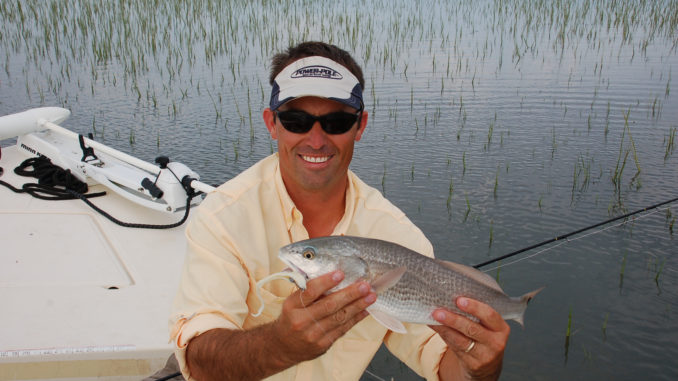
Tailing reds offers fly anglers the perfect opportunity to send a hand-tied fly into the path of a stout redfish.
Typically, redfish cruising the shallow grass flats are quite visible, giving the fishermen ample opportunity to prepare and make the perfect cast — just in front of a feeding fish. Successful fly fishermen will gear up specifically for tailing reds with the right set up and angling method.
With the average cruising redfish weighing between six and 12 pounds, knots, leaders, and other terminal tackle quickly run through an endurance and strength test upon hookup. Medium-heavy fly rods in 8- to 9-weight with matching reels are recommended. Natural or sand-colored floating line is preferred, since the leader and tippet should be relatively short. Shorter leaders also help anglers make accurate casts on the first shot. Six feet of leader in the 15- to 20-pound test range are ideal for battling redfish in the marsh grass.
A fisherman may get many opportunities on a tailing tide, but most present only a single cast. Made that one shot count.
Redfish are sidetracked with their focus on the bottom, but the water is still shallow, and the fish can still be easily spooked. Anglers should limit movement and only cast towards visible fish. Anglers should make their cast when they feel comfortable shooting the fly to its ideal location. Try to limit false casting as much as possible.
Lure or fly choice for tailing reds is like matching the hatch on a high-country trout stream. Capt. Chad Ferris specializes in fly-fishing charters, and he likes to use any fly that resembles something a redfish regularly eats on the flats.
“Redfish are prowling the flats predominantly looking for fiddler crabs, and any crab pattern usually produces positive results,” said Ferris, who said a Merkin Crab as his “go-to” fly for tailing redfish. “Redfish also take small minnows and shrimp along the flats on the flood tide. Spoon flies, Dahlberg Divers and other reaction-type patterns in dark colors entice strikes, especially when the water is a little high on the flats.”
Capt. Robert McCarley prefers dark fly patterns in brown and copper for tailing redfish.
“The famous copperhead redfish fly pattern works wonders on redfish in the flats and in the back of creeks, too,” he said. “ut if you put the fly where it needs to be, the pattern and color does not really matter.”
He prefers to land the fly three to four feet ahead of the projected path of a fish, and he gives the fly just enough action to get the fish’s attention.
Editor’s Note: This story appears as part of a feature in South Carolina Sportsman’s November issue. To ensure you don’t miss any information-packed issues in the future, click here to have each magazine delivered right to your mail box.


Be the first to comment